#civil war naval history
Explore tagged Tumblr posts
Text
FDR the Naval Art Collector

Franklin Roosevelt was an avid, lifelong collector of prints, engravings, and paintings illustrating the history of the United States Navy. In 1922, he purchased this Xanthus Smith painting from Newman F. McGirr, a Philadelphia book and art dealer. FDR often purchased naval artwork from McGirr during the 1920s and 1930s.
Smith was a marine artist who served in the United States Navy during the Civil War. He is best known for his depictions of important naval battles of that war—a special interest of FDR’s.
Roosevelt was initially attracted to this painting of the 1862 battle between the CSS Virginia (formerly the USS Merrimack) and the USS Congress, which he found listed in a McGirr catalog. One of his Delano relatives had been instrumental in the Merrimack’s construction. Roosevelt approached this purchase cautiously. In a March 7, 1922, letter to McGirr he noted: “I should not care to have it if it were one of the paintings of Mr. Smith which looks more like a mathematical drawing than a work of art, but if it is one of the better paintings I should be glad to have you send it over to me at 49 East 65th Street, New York City, to see.”
After viewing the painting, FDR paid McGirr $42 for it. He attached a note to the bill: “Glad to have—Much better than I thought! FDR.”

Join us throughout 2023 as we present #FDRtheCollector, featuring artifacts personally collected, purchased, or retained by Franklin Roosevelt, all from our Digital Artifact Collection: https://fdr.artifacts.archives.gov/objects/7402
Read more about FDR's naval art collection on our blog: https://fdr.blogs.archives.gov/2020/09/03/fdrs-naval-art-collection-history-captured-on-canvas/
#fdr#franklin d. roosevelt#fdr the collector#naval art#naval history#us navy#civil war history#civil war naval history#museum from home#museum collection#artifact collection
12 notes
·
View notes
Text
Canister shots from the Mary Rose
These wooden containers, found packed with flint, are canister shot, which would be loaded into the ships guns and fired, fragmenting and sending sharp shrapnel towards the enemy, destroying rigging and seriously injuring personnel.
These represent the three types of canister shot recovered from the Mary Rose and were made before 1545:



Cylindrical lantern shot: Manufactured in a similar fashion to lanterns, panels mounted to discs at either end.
Cylindrical canister: a single piece of wood cut in half lengthways and hollowed out to provide a central container, led together with string.
Conical lantern shot: Tapering staves are bound together to form a cone. A separate top is pegged to the ends of the staves.
In the course of the 18th century, these shots developed into the canister shots and the grapeshots

Artillery shot-canister for a 12-pounder cannon from the US Civil War era
Canister shots now have a metal canister and are filled with round lead or iron balls that are packed with sawdust to give the mass more strength and cohesion and to prevent the balls from crowding each other when fired.

Stool of Grapeshot, 1800-24
A grapeshot is a type of ammunition that consists of a collection of smaller-caliber round shots packed tightly in a canvas bag and separated from the gunpowder charge by a metal wadding, rather than being a single solid projectile. When assembled, the shot resembled a cluster of grapes, hence the name.
#naval history#naval weapons#canister shot#grapeshot#mary rose#civil war#tudor era#early 19th century#16th century#19th century#age of sail#age of steam
130 notes
·
View notes
Text

Hey all, first post I'm going to do here.
I'm going to talk about the USS Indianola (pictured above), mainly because the story surrounding this could honestly be an idea for a potential sam o'nella video.
The USS Indianola was a casemate ironclad which served under the Union during the civil war. The ship was built by Joseph Brown of Cincinnati, OH for the US Government for $128,000 dollars at the time or about $4,000,000 adjusted for inflation.
By September 1, 1862 construction was nearly complete, however this would be halted when Union Forces under General Lew Wallace seized the unfinished ship the day after and would be launched on the fourth that month in order to defend Cincinnati from Confederate Forces. When the Threat ended on the 12th that month, the ship was returned for completion and would be officially commissioned later that month.
The thing would finally be completed on December of 1862, but the Ohio River's water levels were too low to cross the Falls of the Ohio. Eventually on January of 1863, she would join the Mississippi Squadron at Cairo, IL.
During the Vicksburg Campaign, Union Navy Rear Admiral David Dixon Porter would order the USS Queen of the West (pictured below) down the Mississippi in order to intercept Confederate Shipping between Vicksburg, MS and Port Hudson, LA and would operate there until the 5th of February, 1863. Remember the Queen of the West as she becomes relevant later on.
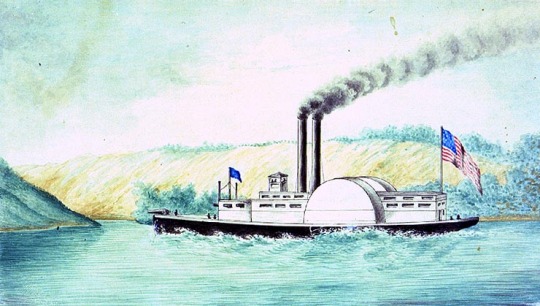
The Queen of the West would later make a second trip and entered the Red River on February 14. Indianola would now be under the command of Union Navy Lieutenant Commander George Brown. Indianola would leave her moorings at the Yazoo the night before with two barges loaded with coal strapped onto her sides and steamed south under fire from the Vicksburg defenses. She would link up with Queen of the West in her operations down the river. After passing Confederate positions, she would anchor for the night and resumed sailing toward the south.
Indianola had been specifically chosen for this operation because her engines would allow her to reach a speed of 2 Knots (or 2.3mph/3.7kph) upstream against the current making it a lot faster than other ships under Porter's Command making her a better fit for escaping upriver if there were an emergency.
Queen of the West would disabled in a fight against Confederate Shore Defenses along the Red River and had to be abandoned. Her crew would make it to the Indianola on a captured packet steamer while being chased down by the Confederate Steamer CSS William H. Web.
Indianola would move against William H. Webb and would eventually spot her that afternoon. Indianola fired it's guns but William H. Webb was out of range and managed to escape into the fog. She would eventually hold a blockade of the junction of the Red and Mississippi, but withdrew on the 21st after learning William H. Webb, the captured and Repaired Queen of the West, and two steamers filled with Confederate soldiers were moving to attack her.
Indianola would be slowed by the two coal barges she was bringing and would be caught on the night of the 24th by Wiliam H. Webb and Queen of the West. Brown would face the Indianola toward the Confederate Ships and prepared for the inevitable fight by positioning the ship so that one of the coal barges were inbetween Indianola and the Confederate Ships.
She would fire her guns at the Confederate Ships, missing her shots. Queen of the West would ram Indianola on her left side and nearly smashed one of the barges in half. The William H. Webb would ram the Indianola Head-On immediately after with the William H. Webb also being damaged in the Collision.
Queen of the West would move upstream to build momentum and rammed the Starboard Side of Indianola, destroying one of the rudders and the Wheelhouse. The William H. Webb would perform a similar manuever, damaging the Indianola's Stern. Brown ordered the ship to fire, some say that the Indianola only scored a single hit on the Queen of the West which caused casualties but did basically no structural damage. Others say the Indianola scored two hits on the Queen of the West which one disabled cannons and also hit William H. Webb once.
At this point, the Indianola was barely functional and was sinking rapidly and Brown had the ship run aground to the Western Bank of the River and lowered the ship's flag. The Confederates were able to pull the ship over to the Eastern Bank which they held. Indianola would sink in 3 meters of water. During the fight, Indianola would be rammed seven times. All but one sailor onboard would survive the battle, but only three escaped the ship's capture to bring word to Porter. Brown and most of the Crew had been taken Prisoner.
The Confederates would dispatch a salvage crew to raise Indianola. The Union High-Ups knew if the Ship was repaired and added to the Confederate Navy like Queen of the West was, it would be disastrous for the Union Fleet on the Misssissippi and considerably harm the war effort.
Now, this is where it gets funny:
Porter did NOT have any ships available to send on the mission to destroy the Indianola before it fell into Confederate Hands, so he ordered the construction of an "Ironclad" in order to scare the Salvage Crew into abandoning the Wreck. This "Ironclad" would be made by lengthening an old Coal Barge with logs and adding a Casemate, Fake Cannons made out of Logs, and two smokestacks made out of Pork Barrels. The "Ironclad" would be given the name "Black Terror" and would be sent downstream on the 26th.
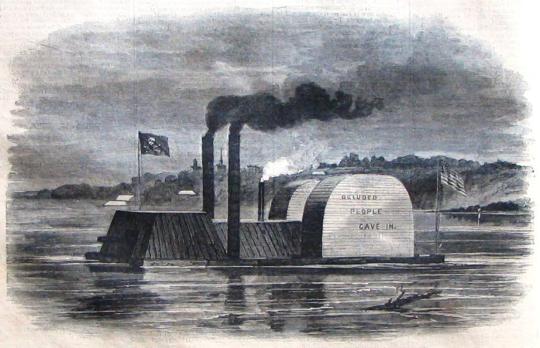
The Black Terror would pass the Vicksburg Defenses without any major damage and scared the Queen of the West into leaving the area of the wreck. The Salvage Crew (who were allegedly drunk at the time) threw the Indianola's 9-Inch Guns into the Missisippi and pointed the 11-Inch Guns at eachother muzzle-to-muzzle and fired them at eachother before burning what remained down to the Waterline.
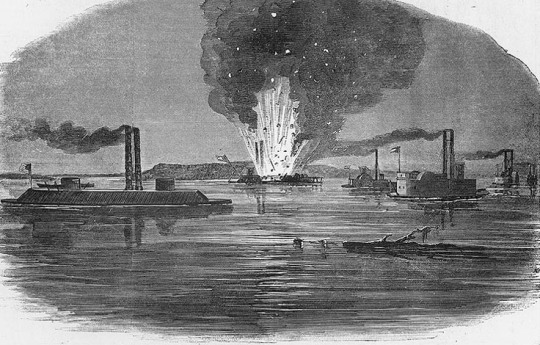
On the 27th, the Confederates would realize the Black Terror wasn't an actual Ironclad Warship. Vicksburg would fall to Union Forces on July 4th and the Remains of Indianola's wreck were raised on January 5th of 1865 which were sold in Illinois on January 17th.
21 notes
·
View notes
Text
USS Monitor exhibit Newport News VA





It’s starting to get to the point where you can call me your idiot “tour guide”. I’ll allow it.
9 notes
·
View notes
Text

The Battle of the USS "Kearsarge" and the CSS "Alabama" by Édouard Manet, 1864.
We are just past the 160th anniversary of the single-ship action off Cherbourg, France that saw USS Kearsage defeat CSS Alabama on June 19th, 1864. The superior gunnery of the Union ship was a key factor.
#age of sail#age of steam#military history#naval battle#american civil war#1860s#uss kearsage#maritime history#manet#édouard manet#the sea#infuriating aftermath to this battle#seascapes#marine art
14 notes
·
View notes
Text
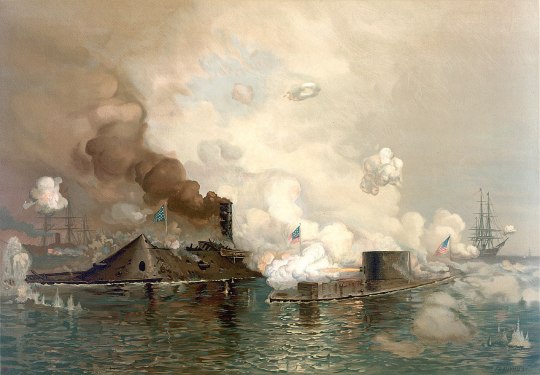
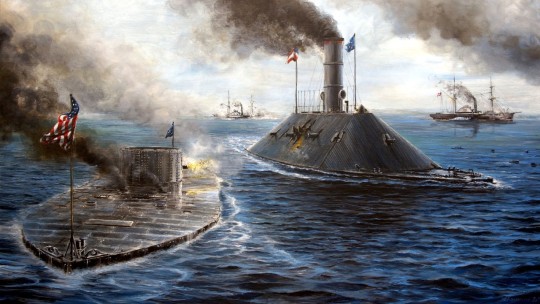
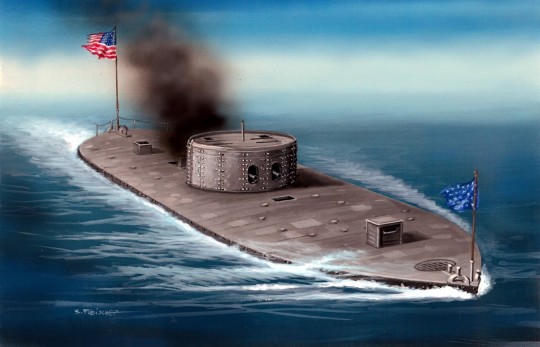
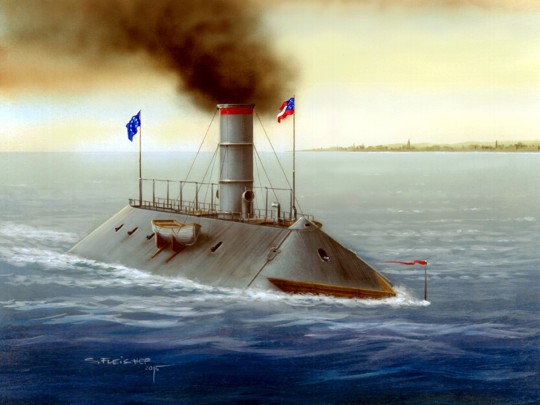
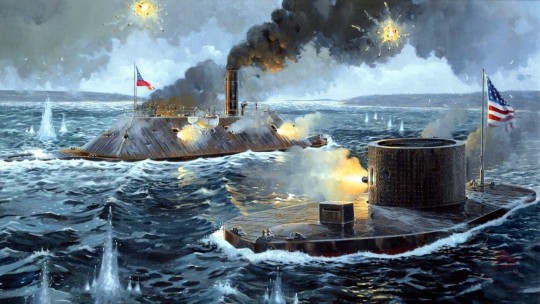
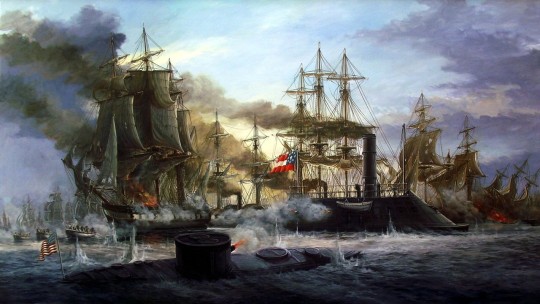
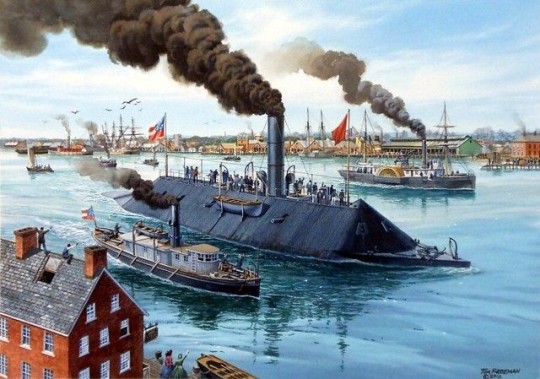
The Battle of Hampton Roads. American Civil War. The famous showdown between the Ironclads USS Monitor and CSS Virginia. Ultimately the two vessels pounded on each other for a while then went their separate ways, the outcome undecided. But it was a turning point for warship combat.
#civil war#american civil war#hampton roads#Monitor#Virginia#ironclads#history#naval history#military history#seabattle#warship#art#artwork#war art#military art
7 notes
·
View notes
Video
youtube
Ask A Mortician - Caitlin Doughty
This Civil War Submarine Vanished for 136 Years A Civil War submarine powered by hand cranks and lit by candlelight. What could possibly go wrong? Meet the HL Hunley.
#this was such an interesting video#all of her videos are awesome#hands down favorite youtuber#she's also a great writer#caitlin doughty#ask a mortician#hl hunley#civil war history#submarine history#naval history#submarines#tw claustrophobia#tw drowning
2 notes
·
View notes
Text
June 19, 1864 Battle of Cherbourg France. The CSS Alabama was sunk by the USS Kearsarge. But not without a fight. This shot is still embedded in the side of the Kearsarge today at the Navy Yard. Both the quality of the powder and the coal were thought to have played a part in the Alabama’s loss. The British yacht the Deerhound rescued many in the crew including Captain Semmes. Unfortunately David White a slave from Delaware, who had been freed by Captain Semmes, from a Yankee ship, drowned that day. He is forever immortalized in the sea.
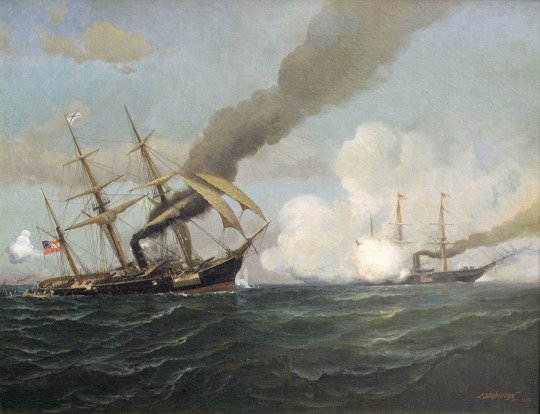
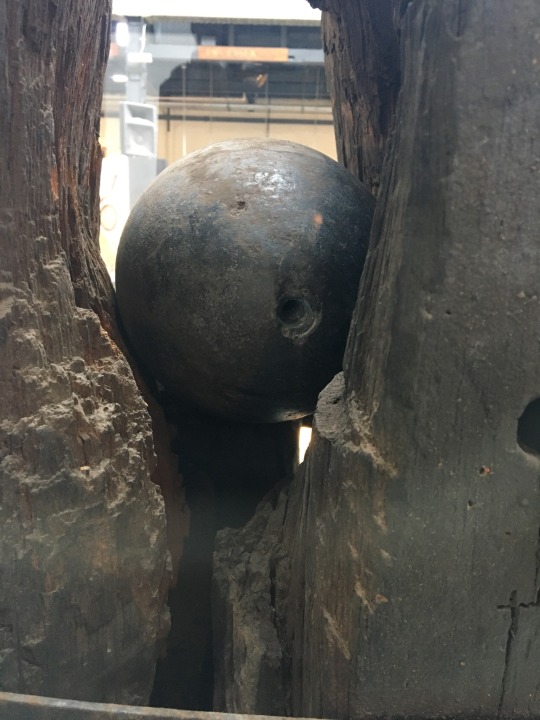

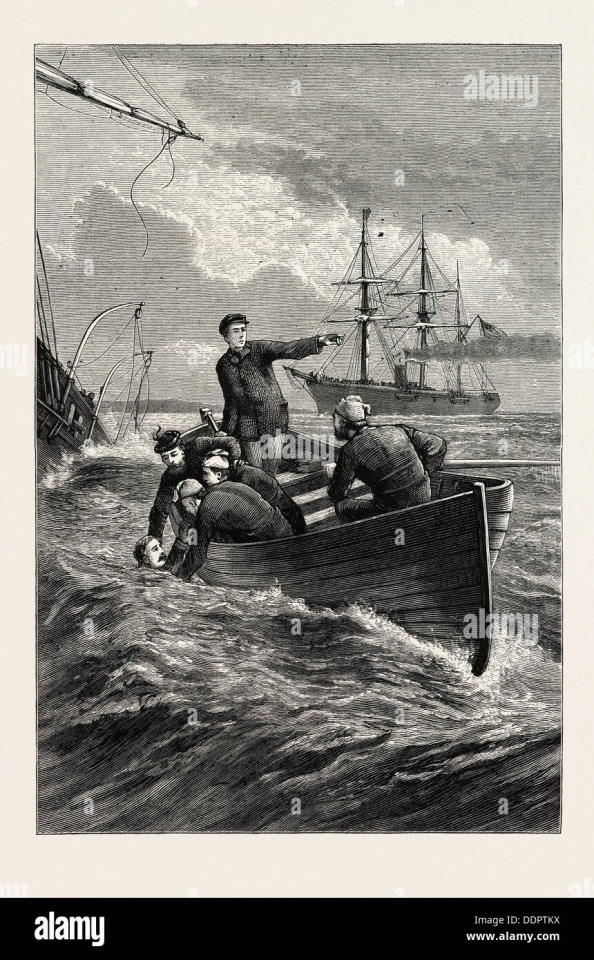
#alabama#civil war#southerners#states rights#confederate#history#gravestones#france#british museum#rebel#black confederate#humanity#confederacy#naval history#us navy#europe#circa 1864#1860s art#1860s#virginia
10 notes
·
View notes
Text
I think I came across this article when I was searching for Farragut's midshipman warrant photo, but hey...this was just as interesting! 😏😌🌊
I love reading about the juxtaposition of two opposing officers from American Civil War (doesn't even have to be "brother against brother" but that's definitely noteworthy ofc), especially if they ended up facing each other in a battle.
A superbly written article by Craig Symonds I mean why did I doubt him to begin with 🥴🤪🙈, you should definitely read it if you're interested in Farragut and his moldy goon of an adversary at Mobile Bay (as yours truly does 😌🤭)
#oh god this is a nicely woven article#sorry for the jumpscare in the preview but oh well...🤷🏽#article#link#david glasgow farragut#david farragut#american civil war#battle of mobile bay#franklin buchanan#farragut friday#american history#us naval history#us navy#also symonds DOES know about farragut's OG namesake...#...just why doesn't he mention it more often 🤨😒
2 notes
·
View notes
Text

One of the most-retold battles of the Civil War is the clash during the Battle of Hampton Roads, between the ironclads USS Monitor and the CSS Virginia --the latter of whom had been constructed over the hull of the converted screw frigate USS Merrimack. While neither vessel inflicted significant damage upon the other (nor did either side gain any real tactical advantage), the battle is nevertheless historically significant as it decisively ushered in the end of the era of wooden-hulled ships. However there is an equally compelling behind-the-scenes tale of how the Union was galvanized into rushing the Monitor into production so speedily, and that story centers around Union spy Mary Louvestre (possibly also spelled Touvestre). There are numerous conflicting (and exaggerated) accounts of Louvestre's heroism; one of these is a popular-but-fictionalized account authored by My Haley, titled The Treason of Mary Louvestre.
Born free in 1812 Norfolk, Virginia to parents originally hailing from French San Domingue, Mary (neé Oglivie) grew up identifying as biracial ("mulatto") and while the details of her childhood and formative years are mostly unrecorded, in 1838 she is on record as having registered as a business owner in the city --while the archived document does not specify the nature of the business, it is popularly assumed that it would have either been an entertainment venue (such as a restaurant or a bar), or a boarding house. But perhaps more significantly, a year later, Mary is recorded as having purchased an enslaved 10 year-old boy, Mark Rene De Mortie, who also came from the same part of San Domingue as her parents. She taught De Mortie to read and write, and emancipated him in March of 1850, just shy of what would have been his 21st birthday, and while he headed off onto a fascinating journey of his own, we'll have to leave that tale for now (watch this space for a future lesson!). In 1844 Mary married Michael Louvestre, another free French "mulatto" from Guadeloupe, who is assumed to have arrived in Norfolk sometime in 1837. The marriage produced three children but two died in childhood due to the then-yellow fever epidemic, and only one daughter, Susan, survived into adulthood. Susan and her husband produced one grandchild, Robert, before they both likewise died, and Robert was raised by his grandparents.
Throughout the 1850s Mary continued to obtain business licenses to operate additional boarding houses, while Michael worked just across the river from their boarding house... at the Gosport Shipyard in Portsmouth. Which brings us up to 1861. Once the Civil War kicked off, Michael happened to be working as a tool keeper in the steam engineering department, where he and several other machinists and shipyard employees had the opportunity to watch, firsthand, the beginning of the Confederate project to convert the Merrimack into the Virginia. The Louvestes enjoyed relative "invisibility" due to their age and their race, and realized the threat such a vessel would present to the Union blockade. In February 1862 Mary, with the help of her husband and his co-workers, snuck onto the shipyard and traced a near-perfect copy of the plans, sewing them into the hem of her dress. She then traveled unnoticed to Washington (likely by steamboat and not on foot as some more fanciful accounts insist!) and delivered the copied plans for the CSS Virginia directly to Secretary of the Navy Gideon Welles. Work on the Monitor promptly picked up the pace, ensuring that the vessel would actually be present in time to square off against the Virginia, and thwart what would have otherwise been an uncontested Confederate domination of the entire Hampton Roads area. After the war, Secretary Welles travelled in person to what was now known as the Norfolk Naval Station, and inquired after Mary so that he might present a reward for her services to the Union, though history does not record what form (if any) that reward ultimately took. That same year she did compose a letter to Commodore A. H. Kilty at Norfolk Naval Shipyard, where she spoke of "Our Navy" and its "heroic defenders." This letter was retained as part of Welles's collection.
Michael died in 1880 and Mary followed shortly afterwards in October of 1883. On November 8, local newspaper The Norfolk Virginian, bore a front-page headline of "Death of a Respected Old Colored Woman;" the verbiage being significant because newspapers rarely reported on the goings-on of Black Americans. "Mary Louveste, an old and respectable colored woman, was found dead in her bed on yesterday morning in her house at the corner of Newton's Lane and Nivison Street." The article goes on to speak of Mary and Michael's marriage: "the two always bore excellent characters (sic) and stood well in the community by reason of their thrift and polite bearing. The old woman possessed some property and recently sold her house for upwards of $2,000. Efforts were lately made to get her to go to the hospital to spend the rest of her days, but she refused to go." No mention is made in the article of her brief-but-critical career in espionage, nor of her connection to Secretary Welles. No visual representation exists of Louvestre; my accompanying illustration is taken from a conjectural sculpture by a local artist.
#black history#civil war#hampton roads#virginia#monitor#sewells point#fort monroe#gosport shipyard#norfolk naval station#mary louvestre#teachtruth#black history month
1 note
·
View note
Text
2025 Winter Lecture Series | John Fitzpatrick
This lecture by John Fitzpatrick is supposedly about holding Britain accountable for constructing confederate raiders. Unfortunately, the presentation was poorly organized, and he spent far more time on the raiding than on holding Britain accountable, which was supposed to be his topic. His unfamiliarity with the technology was also distracting. The video’s description reads, “Dropping Dimes –…
youtube
View On WordPress
0 notes
Text
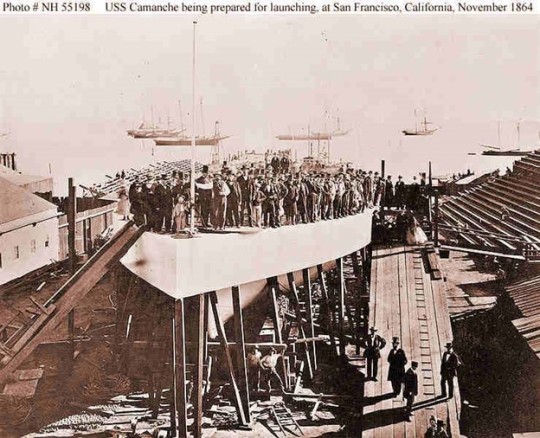

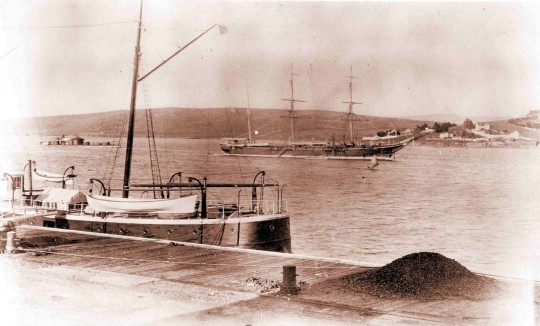


San Francisco’s Battleship
During the late 1800’s the Mare Island waterfront was defined in part by the presence of a warship with the dubious distinction of having been sunk, before it was launched. That ship owed its presence to our Nation’s bloodiest conflict. When Confederate General P.G.T. Beauregard bombarded and captured Fort Sumter in 1861 his action started the Civil War. The war was primarily fought in the East, but California was certainly not immune to the impact of the conflict. With the outbreak of war, most federal troops and warships were withdrawn from California and sent to the east. The loss of those troops jeopardized the ability of the government to counter the actions of southern sympathizers, confederate raiders, ongoing Indian wars and to provide a show of force to dissuade foreign nations who were tempted to weigh in in support of the Confederacy. The lack of a credible navy presence on the Pacific also increased anxiety that San Francisco lay nearly defenseless to Confederate raiders and foreign warships should they ally with the rebellion. In fact, unknown to the residents of San Francisco the Commanding Officer of the Confederate Raider CSS Shenandoah which had been pillaging northern shipping throughout the Pacific eventually turned his sights to attacking San Francisco under cover of darkness and conducting a prolonged bombardment to demand a ransom from the City. His plans were only foiled when the Civil War ended before he could reach San Francisco Bay.
Efforts to bring an iron clad warship to San Francisco Bay to improve San Francisco’s defenses gathered steam following the successful battle of the USS Monitor with CSS Merrimac at Hampton Roads, Virginia in 1862. That battle proved the superiority of iron clad warships ushering in a new era of naval warfare. The California congressional delegation became even more resolute, lobbying hard and successfully to have one of the vitally important new monitors, the USS Camanche, assigned to the San Francisco Bay Area. Camanche was to be built in New Jersey, but there was a problem. To get to San Francisco, she would have to travel around Cape Horne and there was no way the low freeboard ship would ever survive such a trip. The solution was to build the ship, disassemble it and ship it around the Horn within another vessel. By 1863 the Camanche was loaded aboard the square rigger, AQUILA, and set sail for California where a hastily assembled consortium stood ready to reassemble her. In November AQUILA arrived in San Francisco and then Murphy’s Law (Whatever can go wrong, will go wrong) took over. Just two days later a tremendous gale struck and “blew a perfect hurricane.” AQUILA sank at the dock and the Camanche sank with her. Salvaging the Camanche became a nightmare.
Finishing the Camanche required solving the technical problem of salvaging her components locked in the bowels of a square rigger on the bottom of the bay, and untangling a web of intertwined contractual, financial and insurance issues. After several failed attempts to salvage the Camanche, a crew of professional wreckers from New York were brought in and 7 months after sinking the last of the parts had been raised from the bay. The confusing mess of legal claims holding up the assembly of the ship was not resolved until the San Francisco Board of Supervisors authorized $60,000 to the contractors to compensate them for their losses. That payment was sufficient to get the work on the ship going and by the end of 1864 Camanche was launched in front of a crowd of 25,000 people. The Camanche was delivered to the Navy at Mare Island in early 1865, she was officially accepted on February 11, and she was commissioned on August 22, six months after the end of the Civil War. The much sought-after monitor would spend the next 34 years of her service mostly laid up in ordinary at Mare Island until she was sold in 1899 and converted to a coal barge.
Camanche may not have contributed to the war effort, but the consortium that reassembled her evolved into the Union Iron Works in San Francisco. That firm went on to construct a significant percentage of the new steel navy in the late 1800’s. It is likely that their ultimate success with the Camanche influenced the principals of Union Iron Works and the Navy to further pursue naval shipbuilding on the Pacific Coast. That $60,000 investment that the San Francisco Board of Supervisors made in the Camanche was repaid a hundred-fold in economic benefits from the business activity that resulted Union Iron Works entry into the shipbuilding business.
Dennis Kelly
#mare island#naval history#san francisco bay#us navy#vallejo#san francisco#california#Civil War#Comanche#confederate raider#shenandoah#ransom#battleship#monitor
0 notes
Text
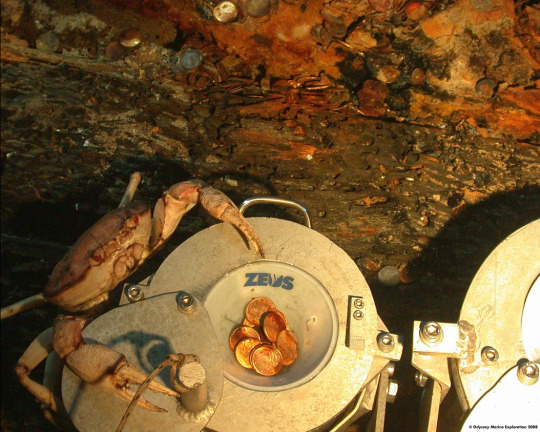
Oi oi what ya doing ? These are my coins- put them back - the locals of the wreck of SS Republic are not pleased with the visit of a group of archaeologists
#naval history#naval artifacts#ss republic#age of steam#shipwreck#underwater archaeology#1865#civil war
203 notes
·
View notes
Note
I’m suddenly getting swathes of Lancer hate across my feed… Has something happened in the fandom? “Union is ______ how could they paint them as even remotely good. They allow _____, and I hate the devs they are ______. The whole thing is just 40k with communist veneer”.
Like am I taking crazy pills…? I thought that all of the problems were literally like right there on the tin “we are a utopia in progress! We will obtain it by any means possible even if it means being everything we say we are not/fighting against. As the player you decide what is right. How much will you ignore for someone else’s idea of utopia?” Like doesn’t it mean all the tools to actually change are there and that is the HOPE aspect of all of this?
(Sorry if this in incoherent grammar is a weak point and I pulled something in my back simply standing up. Now I am sad and crook backed in spasmodic pain)
This isn't an argument I feel super enthusiastic about stepping into, because it gets the most annoying sort of people in your mentions eager to maliciously misrepresent what you say.
However, yeah, there are some pretty terrible readings of Union floating around. I'd invoke "media literacy" because think that a lot of this comes from people not really holistically engaging with the fictional future history of Lancer, but also from a sort of dogmatic purism that requires future societies to be flawless, else they're irredeemable.
It is important to note that ThirdComm is the direct descendant of two highly imperfect societies. FirstComm was formed as a response to the Three Great Traumas of discovering the Massif Vaults (and thus that they were the inheritors of a fallen world), the wars over the Massif Vaults, and the discovery of the lost colonies, all of which collectively showed humanity how close it had come to total extinction.
FirstComm decided that it had a responsibility to ensure that humanity never risked extinction again. It manifested this by trying to colonize every habitable planet it could find, pumping out ship after ship to seed the cosmos with as much human life as it possibly could. This led to problems when it encountered civilizations like the Karrakin Federation and the Aun, who had been carrying humanity's torch just fine by themselves, thank you very much.
SecComm was an Anthrochauvinist fascist state. The book defines it thusly:

We can see a lot of Anthrochauvinist historical romanticism in the mech naming schemes of Harrison Armory, SSC and IPS-N - the fact that Harrison Armory names its mechs after great military leaders of pre-Fall Earth history, IPS-N does the same with naval figures, and SSC uses the names of Earth animals. Even the GMS Everest is named for a mountain on Earth. It's very Cradle-centric.
Anthrochauvinism was, to be clear, largely just an excuse for colonialism and hegemony. Atrocities could easily be justified under by stating that whoever they're being committed against were a threat to the Continuance of Humanity - a term that SecComm got to define.
It's also at this point that we have to zoom in from broad sociopolitical points to address one very specific piece of history: the New Prosperity Agreement. This was signed to prevent the outbreak of a Second Union-Karrakin War, and mandated that the Karrakin Houses would maintain privileged levels of autonomy within Union, and that they would be granted colonial rights to the entire Dawnline Shore. This agreement, struck in 3007u, basically defines much of the current political situation today.
ThirdComm was a final and inevitable reaction to the atrocities, abuses and excesses of SecComm. The unspeakable horrors of Hercynia were the spark, but I need to stress how little Hercynia actually mattered in the larger Revolution - at the start of NRfaW, it's explicitly stated that almost nobody in the galaxy even knows where it is, let alone what happened there. The Revolution was a generalized response to SecComm's tyranny, with no single rallying cry.
The Revolution might also have failed entirely, but for a critical error by Harrison Armory: pissing off the Karrakin Trade Baronies. After getting kicked off Cradle, the Anthrochauvinist Party organised a fleet at Ras Shamra to try and retake Cradle. Simultaneously, however, they were attempting to secure protectorate agreements to steal worlds in the Dawnline Shore out from under the KTB. Putting these two together and making five, the KTB assumed that the fleet was pointed at Karrakis, and started the First Interest War.
The First Interest War initially favoured the KTB. They smashed the fleet above Ras Shamra and simultaneously conquered the moon of Creighton in the Dawnline Shore. However, they underestimated just how ruthless Harrison I was - he "retook" Creighton by relativistic bombardment, and then conquered four of the 12 worlds of the Dawnline Shore with mechanised chassis, a technology the KTB had not adopted and had no counter for.
To prevent further loss of life, Union was eventually forced to broker a peace agreement that saw Harrison I handing himself over to Union justice in return for Harrison Armory's continued sovereignty, and the KTB joining Union as a full member state.
So, with that historical context out of the way, let me get to the second part of this absurd essay I'm writing.
Third Committee Union isn't a civilization that arose from whole cloth. It's shaped by five thousand years of Union history, six thousand years of post-Fall history, and six thousand years of pre-Fall history before that. It is, ultimately, an extremely well-thought-out and well-worldbuilt fictional polity, in that all of its imperfections come from traceable root causes in its history.
Why does ThirdComm permit the abuses of the KTB? Because to stop them, it would likely have to go to war, and such a war would butcher billions. Worse, to do so, it would probably have to ally with Harrison Armory and make horrific concessions.
Why does ThirdComm permit the expansionism and cryptochauvinism of the Armory? Because to stop them, it would likely have to go to war, and such a war would butcher billions. Worse, to do so, it would probably have to ally with the KTB and make horrific concessions.
Nobody in CentComm likes that Harrison Armory are empire-building expansionists. Nobody in CentComm likes that the KTB has a hereditary nobility and enforces blockades against planets that rebel against it. The problem is that ThirdComm is, in historical terms, still relatively new. They've been around five hundred years, and compared to the 1600 years that SecComm was around and the 2800 years FirstComm existed for, that's not very much.
ThirdComm is attempting to decouple itself from the Cradle-first politics of its predecessor, and to amend the many, many atrocities committed in the name of Humanity. It is not easy to do any of these things. SecComm was defined almost entirely by the fact that if it didn't like what you were doing, it would send in the military as a first response. Every time ThirdComm chooses to do the same, its legitimacy erodes, because the mission of ThirdComm is to prove that diverse, vibrant and compassionate human civilization can exist without devolving into war and bloodshed. ThirdComm always tries diplomacy as a first response because if it doesn't, millions of people could die.
748 notes
·
View notes
Text
Knowing that renaming a ship is considered to be bad luck—which explains why the Royal Navy retained the foreign names of captured ships—I am looking up the circumstances of changing a ship's name. There is a ceremony involved, at minimum, you may invoke Poseidon to acknowledge the new name.
Did the United States Navy follow protocol in renaming USS Robert Smalls? In any event, I think it's fitting to rename a US ship with a name honouring a Confederate victory to that of a man who stole a Confederate ship in the most fearless and dashing way possible.

Robert Smalls: Sea captain, maritime pilot, politician and successful businessman, owner of a fantastic Albert watch chain.
From the linked article by NPR:
His list of accomplishments is almost unbelievable. On a Philadelphia streetcar he was asked to give up his seat to a white man. He started a boycott that led to integration. He served as brigadier general in the South Carolina militia. He bought his former enslaver's house. And he started a school, published a newspaper and founded a railroad.
#naval history#american civil war#robert smalls#maritime#tradition#black history#us navy#military history#uss robert smalls#maritime history#sayonara csa losers
121 notes
·
View notes
Text
✰NEPTUNE IN ARIES✰
A once in a lifetime astrological event!
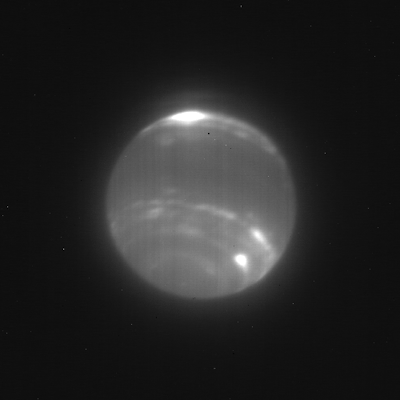
©️GeminiMoonMadness
✧・゚:*✧・゚:* ✧・゚: *✧・゚:* ✧・゚: *✧・゚:*
Neptune takes roughly 165 years to transit the whole zodiac and has been happily swimming through his own sign of Pisces since 2011. Neptune will transit Aries from 2025 to 2039, spending about 12 and a half years there in total, with a few dips in and out at either end. This represents the start of a new cycle of inspiration and change.
✧・゚:*✧・゚:* ✧・゚: *✧・゚:* ✧・゚: *✧・゚:*
Here are the dates:
-Enters Aries on 30 March 2025
-Retrogrades into Pisces on 22 October 2025
-Re-enters Aries to stay from 26 January 2026
-Dips into Taurus on 21 May 2038
-Final visit to Aries from 21 October 2038
-Enters Taurus to stay on 23 March 2039
✧・゚: *✧・゚:* ✧・゚: *✧・゚:* ✧・゚: *✧・゚:*
Neptune was last in Aries from 1861 to 1875 and brought to light humanity´s impulsiveness translated into wars, the creativity to invent and the determination to discover.
As Neptune transits the signs, it reveals what we idealise and look to for redemption or salvation. In Capricorn (1984-1998) it fed the idealisation of corporations and big business and in Aquarius (1998-2012) it idealised science and technology. In Pisces (2011-2025), it appears to be idealising deception itself because we’re all drowning in fake news and propaganda in a crazy-making post-truth hall of mirrors.
✧・゚: *✧・゚:* ✧・゚: *✧・゚:* ✧・゚: *✧・゚:*
WHAT HAPPENED IN HISTORY THE LAST TIME NEPTUNE WAS IN ARIES?
60 – 73 CE
-In Rome Christianity was spreading fast
-In Palestine there was a Jewish uprising against the Romans in 66 and Josephus wrote his history of the Jewish War which became a major source on Jesus.
388 – 401
-Christianity had become the official imperial religion of the Roman Empire in 391
-Theodosius prohibited all pagan cults and worship.
432 – 419 BCE
-The ancient Greek city states were always having falling outs/battling.
-The Peloponnesian War between Athens and Sparta began and ran for decades.
879-892
-Alfred the Great created a small fleet of ships to fight naval battles against the Vikings.
1206 – 1219
-Genghis Khan began his conquest of Eurasia
-The Christian Crusades were in full swing
1370 – 1383
-The Hundred Years War between England and France was going strong, it started in 1337 and ended in 1453.
-The Catholic Church split in 1378 and there were two rival popes until 1417
-The Church came under attack from 1377 by John Wycliffe, an English theologian.
-John Wycliffe (as above) completed the first translation of the Bible into English in 1382.
-1370s, the story of Robin Hood began to circulate (a tale of a classic Aries character).
1534-1547
-Henry VIII broke from Rome and declared himself supreme head of the Church of England
-This led to the dissolution of the monasteries in 1536 and the destruction of religious relics and churches, and endless fighting between Catholics and Protestants.
-In the 1540s Valerius Cordus wrote Dispensatorium, the first pharmacopeia covering medicinal plants, minerals and how to make drugs, published in 1546. He also discovered ether in 1540, which was used in pain relief for surgery – and for getting as high as a kite!
1697 – 1711
- Lots of fighting and rebellions in Europe over various things, including the War of Spanish Succession in which England took Gibraltar in 1704.
-England was getting tired of fighting the Scots, and in 1707 the Act of Union formed a new entity called Great Britain, unifying England and Scotland.
1861-1874
- American civil war commenced
- germ theory was invented
-Violence on the Australian goldfields
-Slavery
-Abraham Lincoln becomes president
-Franco-Prussian War
(Can you notice a trend?)
✧・゚: *✧・゚:* ✧・゚: *✧・゚:* ✧・゚: *✧・゚:*
PREDICTION FOR 2025-2039:
Neptune in Aries could bring pioneering visions that reach into every part of society, with lots of new ideas and progressive thinking. There could be idealistic revolutions and social activism, visionary rebellions, crusades for truth and religious wars. Wars may be fought based on lies and deception (nothing new there then), or fought with bioweapons, chemicals and viruses.
At best, Neptune could inspire compassionate action and leadership that takes us away from the potential for war. But it could just as easily reveal the corruption and weakness of leaders that create power vacuums and trigger war by accident.
There may also be a massive loss of faith in leadership, a loss of belief in the nation or the system. People could turn away from the system out of disillusionment or even boredom, and lose themselves in escapist pursuits, like gaming or virtual reality.
✧・゚: *✧・゚:* ✧・゚: *✧・゚:* ✧・゚: *✧・゚:*
WHAT HOUSE IS YOUR NEPTUNE IN?
WHAT HOUSE IS YOUR ARIES IN?
WHAT DEGREE IS YOUR NEPTUNE?
✧・゚: *✧・゚:* ✧・゚: *✧・゚:* ✧・゚: *✧・゚:*
#Neptune#astrology advice#astrology#astrology observations#astro community#astrology community#astro posts#astro#astrology readings#astrology posts#astro observations#astro transit#transit astrology#Neptune in Aries#Aries#Neptune transit#Astro readings#history#astrology history#astrology predictions#Aries transit#outer planet#astrology transit#astrology event#astrologist#astrology aspects#astrologer#astrology page#Aries history
185 notes
·
View notes